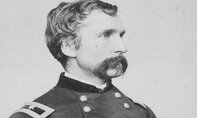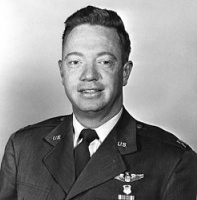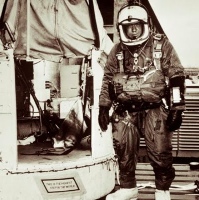- About Us
- Columns
- Letters
- Cartoons
- The Udder Limits
- Archives
- Ezy Reading Archive
- 2024 Cud Archives
- 2023 Cud Archives
- 2022 Cud Archives
- 2021 Cud Archives
- 2020 Cud Archives
- 2015-2019
- 2010-2014
- 2004-2009
 |
The Cud On History: |
Joseph “Joe” W. Kittinger Jr. disproved the quaint Maine belief that “you can’t get there from here” when he flew from Caribou to Italy in mid-September 1984 - by balloon.
Aviation eyes had focused on Aroostook County when transatlantic ballooning captured national attention in the late 1970s. A balloon crossing of the Atlantic Ocean had eluded achievement for years. Not until 1978 did balloonists Ben Abruzzo, Maxie Anderson, and Larry Newman select Maine and specifically central Aroostook County as the ideal site from which to launch their Eagle II helium balloon for another “go” at the transatlantic record.
The County’s geographical proximity to Europe - the very reason the United States Air Force had cited for constructing Loring Air Force Base a generation earlier - meant that the intrepid balloonists could fly a shorter distance to reach the Old World. The Eagle II crew brought balloon and gear to Spragueville, a Presque Isle village, in August 1978 and took off from a pasture owned by farmer Merle Sprague. A monument now marks the site.
Traveling 3,107 miles, the Eagle II touched down at Miserey, France six days later.
Ironically, Joe Kittinger had intended to beat the Eagle II across the Atlantic that summer. Called the “Father of the Modern Day Hot-Air Balloon,” American balloonist Paul “Ed” Yost had constructed the 10-story Rosie O’Grady Balloon of Peace, aboard which Kittinger and another balloon pilot would take off for Europe. The Eagle II beat the Rosie O’Grady out the gate, however, and Kittinger and Yost scrubbed their flight.
Another goal lured them, however; crossing the Atlantic Ocean solo by balloon. Five balloonists had tried, and two balloonists had died. In 1976, Yost had flown his “Silver Fox” balloon to within 650 miles of Portugal before abandoning the attempt. He wanted to make another stab at the solo goal, but if he could not fly, he could send Joe Kittinger.
Perhaps Kittinger was the right balloonist at the right place and in the right balloon at the right time, because few contemporary balloonists were as experienced in high-altitude flight as the man from Florida.
Born near Orlando on July 27, 1928, Kittinger was 56 when he arrived in The County to launch his aerial expedition. During his younger days he had lived an adventurous life, qualifying as an Air Force jet pilot in the early 1950s. After completing various tours, including as assignment as a Germany-based NATO test pilot, Kittinger reported to the Air Force Missile Development Center at Holloman Air Force Base, New Mexico in 1953.
In that pre-Sputnik era, Air Force researchers conducted experiments to see if humans could survive at high altitudes. The Air Force launched Project Man High in 1955; encased in pressurized gondolas attached to massive balloons, pressure suit-clad test pilots ascended to the edge of space. Kittinger made the first Project Man High balloon flight on June 2, 1957 and reached 96,000 feet.
Kittinger enjoyed such “High Flight,” referring to the famous aviator poem penned by John Gillespie Magee Jr. In 1958, Kittinger participated in Project Excelsior, another Air Force balloon-flight effort that saw a pilot not only ascend on high, but leap from his gondola with only two parachutes to hopefully ease his return to Terra Firma.
Stepping into an open gondola on August 16, 1960, Kittinger ascended in a balloon dubbed the Excelsior III. Clad in a pressure suit and layered clothing, Kittinger calmly exited the gondola after hovering at 102,800 feet (about 19 miles high) for approximately 12 minutes.
Before his parachutes fully deployed to deliver him safely earthward, Kittinger hit a top speed of 614 miles per hour. “I had absolutely no sense of the speed,” he reported after attaining a parachute free fall record that has lasted until today. Some snobby early 21st-century parachutists malign the achievement because Kittinger used two parachutes, as mandated by his Air Force superiors. But a hale and hearty Joe Kittinger still lives in Florida, and no braggadocio parachutist has yet surpassed his record.
Kittinger later flew 483 missions during three tours in Vietnam; he even shot down an enemy Mig-21. North Vietnamese gunners nailed Kittinger’s jet on May 11, 1972, and he remained in the Hanoi Hilton for the next 11 months. Kittinger retired from the Air Force as a “full bird” colonel in 1978.
Despite thousands of hours spent flying high-performance jets, he never lost his love for ballooning. During the 1980s, he won the Gordon Bennett Gas Balloon Race four times and also piloted a balloon solo from Las Vegas to New York in November 1983. That flight covered 2,001 miles in 72 hours.
With such extensive ballooning experience, Joe Kittinger believed he could conquer the Atlantic Ocean solo. He arrived at his County launch site at approximately 6:45 p.m. on Friday, September 14, 1984 and promptly received a “rose of peace” from the Caribou Chamber of Commerce.
A day earlier, Kittinger’s crew had delivered a gondola and helium to the site, which was owned by Clifford and Annie Longley. Located off South Main Street some three miles south of downtown Caribou, the grassy field had attracted some 1,000 well-wishers by the time that Kittinger boarded the Rosie O’Grady about 8 p.m.
 Inspecting the balloon and conferring with Kittinger, Ed Yost announced at 8:13 p.m. that “Okay, we’re ready to fly.” About 10 minutes later, Kittinger leaned from the gondola so his girlfriend, Sherry Reed, could tie a white scarf around his neck and kiss him. Two clergy, a minister and a priest, offered prayers.
Inspecting the balloon and conferring with Kittinger, Ed Yost announced at 8:13 p.m. that “Okay, we’re ready to fly.” About 10 minutes later, Kittinger leaned from the gondola so his girlfriend, Sherry Reed, could tie a white scarf around his neck and kiss him. Two clergy, a minister and a priest, offered prayers.
The Rosie O’Grady Balloon of Peace launched at 8:25 p.m.
Favorable winds - absolutely necessary to a successful flight and painstakingly monitored by Kittinger’s ground crew - swiftly funneled the blue-and-silver Rosie O’Grady across the Atlantic Ocean. By nightfall on Sunday, September 16, Kittinger was zooming past Ireland’s south coast, albeit approximately 430 miles offshore, on a course that could see him cross the French coast on Monday morning, said Bedford, Massachusetts flight meteorologist Jim Serna.
“He’s really been booking it,” Serna said, referring to Kittinger. Winds had averaged about 67 miles an hour, with gusts to 75 or 80 mph, and the balloon had flown primarily at 10,000 feet, an altitude that did not require Kittinger to use oxygen.
Those hard-charging winds suddenly lessened late Sunday night. Almost simultaneously, the tracking crew briefly lost contact with Kittinger, and his navigational equipment fulfilled Murphy’s Law: “Whatever can go wrong, will go wrong.” Kittinger spent a few hours essentially stalled off the French coast, but a begrudging breeze finally blew his balloon at 30 mph into French air space over Bayonne at 4:30 p.m., Eastern Daylight Time, only 68 hours since Kittinger had departed Caribou.
With the good balloon and its pilot not in peril, the tracking crew urged Kittinger to continue his record-breaking flight. The Rosie O’Grady had traveled farther southeast than anticipated, and inclement weather lurking over the Alps threatened any attempt to sore above those European peaks.
That bad weather seemingly “went after” Kittinger and his balloon. The Rosie O’Grady was approaching mountains in northwestern Italy; “there was a big thunderstorm on the other side of the mountain, and I was in mountains, and the weather was pretty bad and the winds pretty brisk,” Kittinger said afterwards. “I couldn’t go any further” in the wind-driven rain.
At 8:08 a.m., EDT on Tuesday, September 18, the Rosie O’Grady Balloon of Peace swept into trees during a controlled landing at Cairo Montenotte, Italy. As his 3,543-mile flight ended near Savona, “I got thrown out of the basket, the gondola, and I hit rather hard from about 10 feet or so,” Kittinger indicated. “I rebroke an old injury (an ankle) I had from parachute jumping many years ago.”
He described the flight’s bruising conclusion as “embarrassing, really,” because the incident “marred an absolutely perfect flight. But it’s a small price to pay, and it could have been worse.”
The flight had lasted 83 hours and 40 minutes. Italian authorities rushed ballooning’s latest hero to the St. Roch Hospital in Nice, France. There Sherry Reed caught up with Kittinger and planted on his lips a kiss that was photographed and published around the world.
Around the world: Now that was another ballooning goal that had eluded aeronauts! However, Joe Kittinger would leave this goal to other aeronauts, and on Saturday, March 20, 1999, Bertrand Piccard of Switzerland and Brian Jones of Great Britain would attain the goal in another balloon, the Breitling Orbiter 3, while cruising over Mauritania in North Africa.
